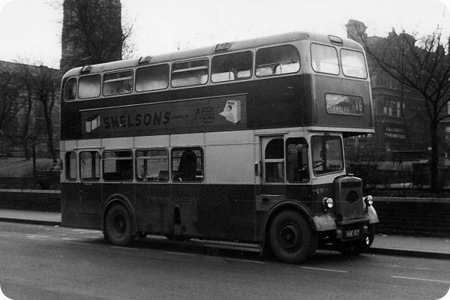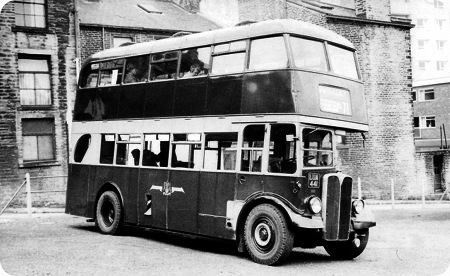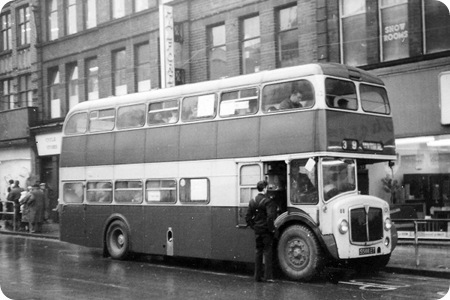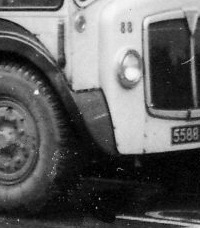Yorkshire Traction – Leyland Titan PD2 – VHE 193 – 1193
Yorkshire Traction
1961
Leyland Titan PD2
Roe H35/28F
Here we are in Huddersfield again on the road where all the non Corporation buses had there terminus, although the odd one did sneak in now and then. I think it was Lord Street and the building on the left is the Parish Church, this is where I think all the buses to surrounding towns i.e. Wakefield, Dewsbury and Barnsley for example started there journey.
Anyway this is a very interesting bus, I have titled it as a Leyland Titan PD2 as it was listed in my ‘British Bus Fleets’ book but actually it was a re-bodied Leyland Tiger PS2/1.
I found in the Roe body list on the ‘Bus Lists on the web’ website that the original Leyland Tiger registration was EVH 211, knowing that VH was an Huddersfield registration I thought I would try to find out who owned it originally. I ruled out the corporation as they were more into AEC single deckers, no way would it be ex Hanson they would have re-bodied it for themselves several times. Then I remembered that Yorkshire Traction were part owners of the Huddersfield based County Motors, so onto the ‘Huddersfield PTG’ website and sure enough there it is EVH 211 fleet no 83 a 1949 Tiger PS2/1 with a Roe B34F body. If you would like to see what it looked like originally there is a link here you will have to scroll half way down the page to find it.
Tracky rebuilt and refurbished many PS1 and PS2 Tigers – so much that they merited new registration numbers. They were always referred to as Tigers, not Titans, after their rebuild and re-registration.
David Oldfield
YTC indeed did rebuild a significant number of obsolete half cab single decks, not all of which were for themselves – for example Stratford Blue had a similar bus to the one shown.
The chassis were, more accurately, built using PD2 chassis rails with running gear and other components salvaged from the donor vehicle.
YTC had an honourable tradition of rebuilding/re-bodying, as an example look no further than the preserved Tiger number 492 with its’ post-war body.
The last vehicles to be rebuilt were the three Leopards in NBC days – Numbers 153/4 and 386.
The first two were, in principle the same format as the PS2s i.e. the donor vehicles (ex Yorkshire Woollen in this case) were simply donors of components as the vehicles had updated chassis rails to PSU3E spec. They received Plaxton Supreme bodies with new registrations. Interestingly they had YTC chassis numbers. The 3rd vehicle in the exercise was very heavily rebuilt utilising the original chassis and body frame with updated running gear, it also gained a new registration.
Andrew
I worked for YTC when 153/4 were in for rebuild. The original chassis rails were retained, also no change to the O600 engine and keeping the original 4 speed gearbox made the outcome very predictable. There was no consideration given as to what type of service these buses would be used on. End result, underpowered and lack of top speed.
Trackyman
29/08/12 – 12:17
If ever there was a box on wheels then this was it It must be amongst the top three ugliest buses ever So bad were these that YTC adopted a modified livery for them to improve their looks but to no avail.
Similar conversion with NCME bodies were very attractive in contrast.
Chris Hough
29/08/12 – 14:55
I agree, Chris, but what are your other two? They certainly did Roe’s reputation no good at all. [People would see the name Roe, not realising it was a PRV design.]
David Oldfield
29/08/12 – 16:38
David my other personal two are Northern Counties Nottingham style bodies supplied to A1 Lytham and Stratford Blue and the ECW bodies supplied to South Yorks PTE complete with peaks fore and aft. I think Colchester also bought some like the Roe rebuilds how could they sink so low.
Chris Hough
29/08/12 – 18:56
I think the ECWs were, essentially, a SYPTE "design" improvement which (sorry, here I go again) ruined the balance and symmetry of the original. They also resulted in some atrocious blind spots which were cured by cutting holes in the pillars to provide better vision. Why on earth Colchester then bought them, goodness only knows. Did anyone else?
David Oldfield
13/05/15 – 06:50
I worked in the body shop at Yorkshire Traction for nearly 50 years from 1956. I had a hand in lifting the old single deck bodies off before the mechanics took over and did a full strip down. The Leyland PS1s were sent to Charles Roe and were fitted with light weight double deck bodies. They were fine for the first few years , but when the metalastic bearer end brackets became tired they creaked and groaned like an old sailing ship when cornering.The PD2s were sent to Northern Counties and the last batch went to Charles Roe, but were built to a design by Park Royal. They certainly looked a little strange. In later years on having passed my PSV all types driving test I had the pleasure of driving on service most of the Leyland conversions.I think of all the various types of buses I drove at Yorkshire Traction my favourite without doubt was the PD2.
Barrie Micklethwaite
18/06/15 – 16:45
To confirm the location, it is Lord Street, Huddersfield where most (all?) the Tracky and County routes terminated.
Tim Jackson
30/05/20 – 06:50
The comments about these re-bodied buses have made interesting reading, I drove these many times in the late 60`s and early 70`s, the crews called them "Banana Boxes", among other things, and you certainly needed to be aware of what type of bus you were driving when it came to these, the body was very light, and when fully loaded they rolled alarmingly on bends, the Vacuum braking system needed thought too, nothing seemed to happen for ages when you pressed the brake, so stopping accurately needed advance planning to allow for they delay, like all the PD2s and PD3s, being half cab they were warm in winter, during the summer it was nice to ride about with the sliding cab door open, and the full window clipped back over the bonnet to get plenty of air, If memory serves me the PD1s had hinged doors and had to stay closed, but you could still open the window.
busman25
Quick links to the - Comments Page - Contact Page - Home Page





